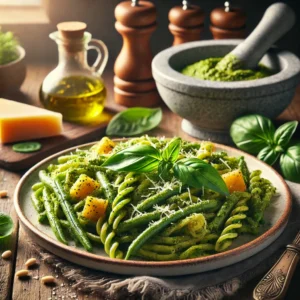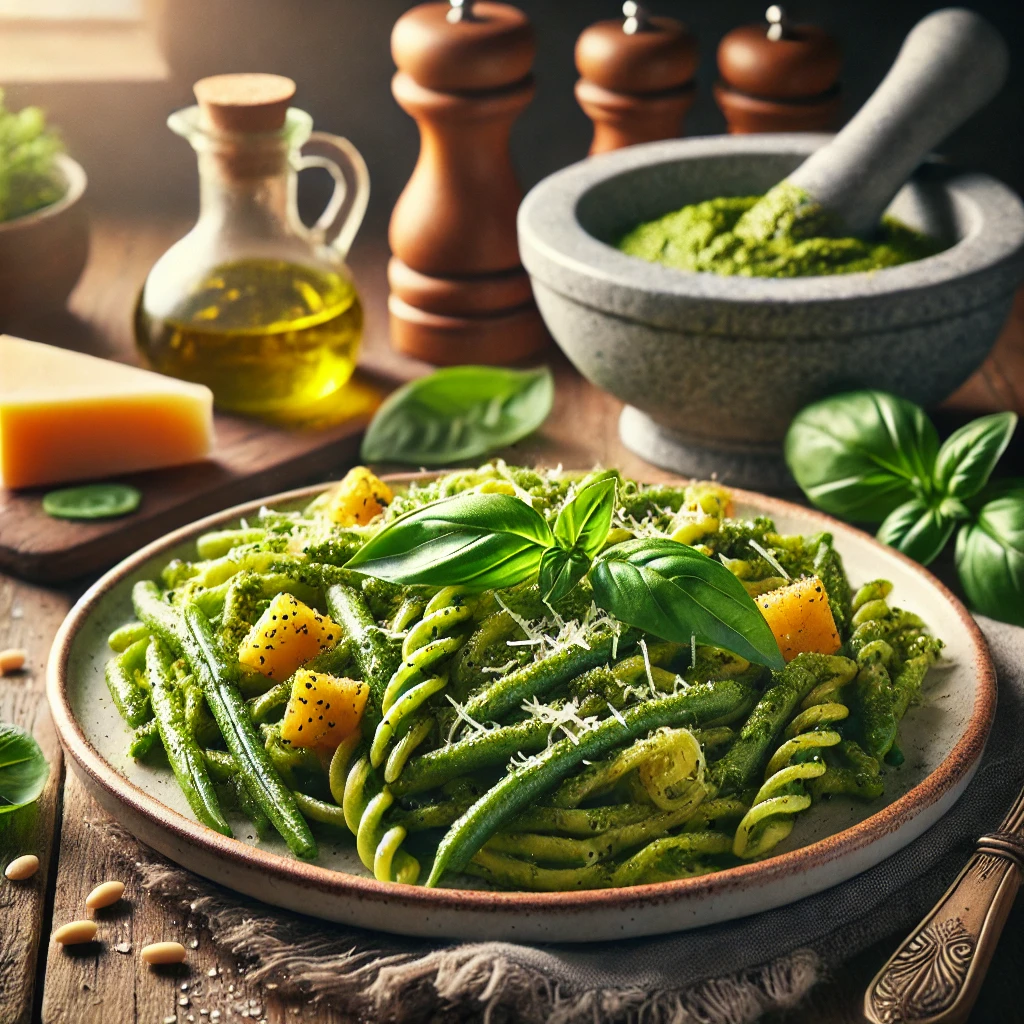The twisted pasta of Liguria, Trofie, from Italy, is more than just a shape; it’s a culinary heritage that speaks of simplicity, tradition, and exquisite flavor. From its humble origins to its enduring popularity in modern kitchens, this pasta has secured its place as a symbol of Ligurian cuisine.
The Origins of Trofie
The history of trofie is deeply tied to Liguria, a picturesque coastal region in northwest Italy. This region, known for its breathtaking landscapes and culinary treasures, boasts a strong maritime culture. Liguria’s cuisine, shaped by its geography, often combines the fruits of the sea with the abundant produce of its terraced hillsides.
Trofie likely originated in small Ligurian villages, where simple ingredients and skilled hands transformed durum wheat semolina and water into a distinctive twisted pasta. The name “trofie” may derive from the Genoese verb strufuggiare, meaning “to rub” or “to twist,” which describes the method used to shape the pasta by hand.
How Trofie is Made
Trofie is traditionally crafted by rolling small pieces of dough between the palms or fingers to create their signature elongated, spiral shape. The texture of trofie, with its ridges and twists, is ideal for clinging to sauces, making it a perfect match for pesto, the region’s iconic sauce made from fresh basil, pine nuts, Parmesan, and extra virgin olive oil.
Though still made by hand in some artisan kitchens, modern production methods have made trofie widely available in dried form, ensuring its reach far beyond Liguria.
Traditional Trofie al Pesto
The quintessential dish featuring this pasta is Trofie al Pesto, a celebration of Ligurian flavors. The dish typically includes tender green beans and potatoes cooked alongside the pasta, adding layers of texture and flavor. This recipe encapsulates the Ligurian ethos of making the most of simple, high-quality ingredients.
Variants of Trofie
While traditional trofie is made from durum wheat, some variations use chestnut flour, a nod to Liguria’s historical reliance on chestnuts during leaner times. These chestnut-flour trofie have a slightly sweeter flavor and are paired with earthy sauces or mushrooms.
Another variant includes adding squid ink to the dough, resulting in a striking black trofie often served with seafood sauces. These modern twists highlight the adaptability of this humble pasta shape.
Trofie’s Modern Popularity
Today, trofie enjoys a resurgence in popularity, particularly among food enthusiasts seeking authentic Italian dishes. While its classic pairing with pesto remains a favorite, chefs and home cooks have begun experimenting with trofie in non-traditional recipes, such as spicy tomato-based sauces, creamy concoctions, and even cold pasta salads.
In Liguria, trofie still holds a place of honor, particularly during festivals celebrating local culinary traditions. Outside of Italy, it has become a sought-after pasta in gourmet stores, representing the artistry of regional Italian cuisine.
Why Trofie Captures the Heart
The enduring appeal of trofie lies in its unassuming nature. It is a pasta that embodies the essence of Liguria: rustic yet refined, simple yet profound. Whether enjoyed in its traditional form or as part of a contemporary creation, trofie connects us to the sun-drenched hills and azure waters of its birthplace.
In modern kitchens, dried trofie is appreciated for its versatility and ability to elevate everyday meals with a touch of Ligurian magic.
Trofie is more than just a pasta; it’s a piece of Ligurian culture, a culinary ambassador that has crossed borders while staying true to its roots. Whether you savor it in a traditional pesto dish or explore its potential in new recipes, trofie invites you to experience the warmth and richness of Liguria, one twist at a time.

Trofie al Pesto
Equipment
- Pot large
Ingredients
For the Pesto
- 25 g Basil Leaves Fresh
- 15 g Pine Nuts
- 1 Garlic Clove small
- 20 g Parmesan cheese grated
- 10 g Pecorino cheese grated
- 30 ml Olive Oil extra virgin
- salt to taste
For the Pasta
- 180 g Trofie pasta fresh or dry
- 50 g Green beans trimmed and cut into 2-inch pieces
- 100 g Potatoes peeled and cut into small cubes
Instructions
Prepare the Pesto
- In a mortar and pestle or food processor, grind the basil leaves, garlic, and pine nuts into a paste.
- Gradually add the grated Parmesan and Pecorino, followed by the olive oil, until you achieve a smooth, creamy consistency. Season with salt to taste. Set aside.
Cook the Vegetables and Pasta
- In a large pot of boiling salted water, cook the potatoes and green beans for 5-7 minutes, or until tender.
- Add the trofie pasta to the same pot and cook until al dente, following the package instructions (usually 8-10 minutes).
Combine and Serve
- Reserve 2-3 tablespoons of pasta water, then drain the pasta and vegetables.
- Mix the pesto with the reserved pasta water to loosen it slightly. Toss the pasta and vegetables with the pesto until well-coated.
- Serve immediately, garnished with additional grated Parmesan if desired.

